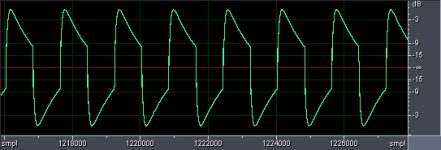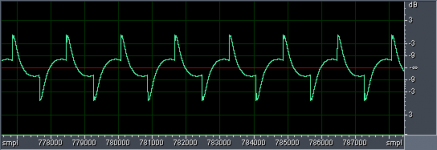Goes without saying if you find one sample has an identifiable glitch but these don't. I'm listening purely to the music and can pick the difference out from just that.
If you read my posts with open mind you will find that i dont have personal motives. Pure scientist motive.
I have never said that what you can do is easy. And i have never said that Pavel's preamp is bad. It is just happen that you are in that positions.
I know you have good ears. And i know Pavel is good (i have built many of his circuits). Here im only trying to propose something that imo very worthy. I have been down this path and im certain. You should understand that feeling.
Read again and look for the message.
Maybe difference of interpretations
I'm agreeing with a lot of what you say in my reply... that it is how the music comes across at the point of listening that is important. The fatigue issue is very very real and very hard to pin down. It is fatiguing when you find your mind wandering and you switch off and do something else instead. You "want" to listen but find the "interest" is not there. That is the real challenge to me, to have a system that has the "wow" factor there all the time irrespective of the basic quality of the material being played.
I'm just trying something right now......
I'm agreeing with a lot of what you say in my reply... that it is how the music comes across at the point of listening that is important. The fatigue issue is very very real and very hard to pin down. It is fatiguing when you find your mind wandering and you switch off and do something else instead. You "want" to listen but find the "interest" is not there. That is the real challenge to me, to have a system that has the "wow" factor there all the time irrespective of the basic quality of the material being played.
I'm just trying something right now......
Please mention one good example where one bad product has gained success in audiophile market (and a non-successful good product for comparison). Do it in a "fair" way (isn't fair for example, if you mention a good product that I have never heard about, no distribution channel, etc).
About half of all audiophile products are "bad" from a scientific point of view. Lowther speakers, SET amps, turntables that cost as much as a car, magical cables that conduct better in one direction, the list is almost endless.
By "bad" I mean that the musical enjoyment delivered per dollar is grossly sub-optimal.
Last edited:
Wow. That is surprisingly (to me) big and very audible. Thanks. It really is on that kind of sound that I hear the differences though.
Hi Mooly, I have just made my probably best attempt to show the audible difference, please try this file:
https://www.dropbox.com/s/x4ffl1nef7oko8w/mango_sss-kiwi_sss.wav
It is extracted from short 10s passage and remains clearly identifiable.
Hi Mooly, I have just made my probably best attempt to show the audible difference, please try this file:
https://www.dropbox.com/s/x4ffl1nef7oko8w/mango_sss-kiwi_sss.wav
It is extracted from short 10s passage and remains clearly identifiable.
Very clear indeed, and not totally all extreme HF.
I've never attempted to make a difference file (yet
The files for subtracting were aligned within 1 sample. Anyway, there is a software that will make both alignment ad file difference for you, in case that 2 files are not too dissimilar
Audio DiffMaker
Audio DiffMaker
The difference is not surprising, because the key reason is the phase shift. Any difference in frequency response (here the 3.4 Hz/-3dB C-R input cap coupling) is reflected in phase shifts and in linear distortion of some kind. The difference itself does not say much about audibility. Remember the 16 x 24 bit test with ATH dither applied to 16 bit file, difference file is inaudible but I have collected many positive ABX results.
Hope you don't mind 
I would be very interested in your thoughts on this one,
Is it live... or is it Memorex... you decide
I would be very interested in your thoughts on this one,
Is it live... or is it Memorex... you decide
About half of all audiophile products are "bad" from a scientific point of view. Lowther speakers, SET amps, turntables that cost as much as a car, magical cables that conduct better in one direction, the list is almost endless.
By "bad" I mean that the musical enjoyment delivered per dollar is grossly sub-optimal.
I know what you mean. Thats why i have mentioned "fair" way, or comparator of a better cable that is not as successful for example.
It is easy to understand that at higher level, improvement per dollar is so small. As long as there is money to be wasted, even 1% of improvement worth a million dollar.
Do you expect everything else in the recording and playback chain, except for this CR input coupling 1st order HP, was DC coupled and able to transfer 0Hz, i.e. DC signal? I guess you do not. Please check headphone 30Hz square response. I am sure you also know how speaker square response look like. Your comments are misleading. There is nothing like square waveforms in music signals. There is no microphone/preamp system that would capture DC and there is no way how to produce positive or negative DC air pressure in the non-sealed environment.
Yes, what you've got pictured is quite typical;
Here is 30Hz square wave response of $10 ear buds I used:

For comparison here is Sennheiser HD650 response for 30Hz square wave:

Listening test, as I've posted already, was performed before analysis. And once files are selected in foobar for ABX, I've no idea which is A or B in each trial. All that is demonstrated is ability to hear a difference.
What segment did Mooly use for differentiating files?
Last edited:
What segment did Mooly use for differentiating files?
Mooly listened to this section,
http://www.diyaudio.com/forums/ever...-listening-test-trial-no-3-a.html#post3721205
1.01 to 1.10 into the track.
Here are the ABX results that I have collected partly here and partly from our local hifi forum. The results are for 2 different tests, the current one and 16 x 24bit (in another thread here).
There are some replies 'can't hear any difference' but without screenshot sent, these replies are not included in the chart.
There are some replies 'can't hear any difference' but without screenshot sent, these replies are not included in the chart.
Attachments
In case of kiwi x mango, all of us who had positive result needed your 'expensssive" hint.
Ahhhh....
We are pushing the limits of what is discernible I think.
New test
I have one more test, file data vs. D/A --> A/D conversion
https://www.dropbox.com/s/3597rrcy2xi7bnl/pearapple.zip
Those who are interested, please post ABX screenshots.
I have one more test, file data vs. D/A --> A/D conversion
https://www.dropbox.com/s/3597rrcy2xi7bnl/pearapple.zip
Those who are interested, please post ABX screenshots.
A good way of putting it ... IME this is all about the low level distortion that's audible - the more there is, the more fatiguing the sound. How do you measure this 'distortion'? Very easy ... at the normal sound level you listen to the music just go across to a speaker and listen only some inches away from the driver. If there is a hard, unpleasant, aggressive, spitty, scratchy quality to the sound, then, there's your 'audible distortion' ...I'm agreeing with a lot of what you say in my reply... that it is how the music comes across at the point of listening that is important. The fatigue issue is very very real and very hard to pin down. It is fatiguing when you find your mind wandering and you switch off and do something else instead. You "want" to listen but find the "interest" is not there. That is the real challenge to me, to have a system that has the "wow" factor there all the time irrespective of the basic quality of the material being played.
The goal is to totally eliminate that ingredient, part of the sound ... what you're hearing is not the "poor quality recording", it's your playback system, playing up ...
- Status
- This old topic is closed. If you want to reopen this topic, contact a moderator using the "Report Post" button.
- Home
- General Interest
- Everything Else
- Ultimate listening test - trial no. 3

